75% of Americans want to see climate change taught in schools, and four more graphs
Posted on 16 May 2014 by Guest Author
This is a re-post from The Carbon Brief by Ros Donald
A new study reveals significant gaps in many north Americans' knowledge about climate change. But the vast majority want to know much more, and 75 per cent want to see climate change taught in schools according to new research from the Yale Forum on Climate Change Communication. We've picked five of the most interesting graphs from the research.
1. Hunger for more knowledge
The study also revealed many Americans don't have a very high opinion of their own knowledge about climate change. Only one in 10 say they are "very well informed" about how the climate system works or the different causes, consequences or potential solutions to climate change. 51 to 52 per cent say they are "fairly well informed".
But a large majority - 75 per cent - say they would like to know more and, as the graph below shows, 75 per cent say schools should teach children about climate change. 68 per cent say they would welcome a national education programme to teach Americans about the issue.
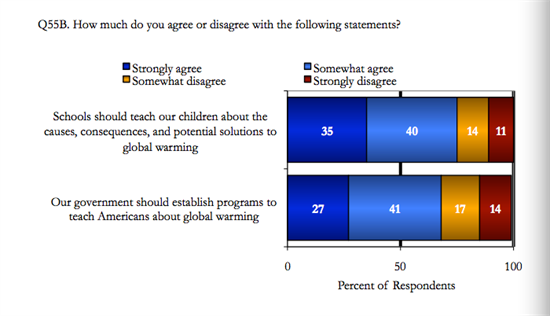
2. Confusion about the causes of climate change
The study finds that 57 per cent of Americans know the greenhouse effect refers to gases in the atmosphere that trap heat, and 50 per cent understand human activities are the cause of extra warming in the atmosphere.
Most people correctly identify activities such as burning fossil fuels and running cars and trucks on petrol as major contributors to climate change. But there remains a large number of people who are confused about the causes of climate change. 73 per cent incorrectly think the hole in the ozone layer contributes at least a little to climate change, for example.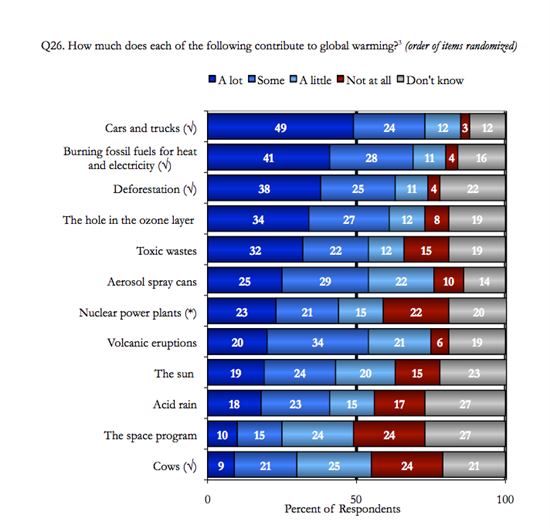
3. Trust: Scientists, specialist media and museums come out top
Americans' most trusted sources of information about climate change are the National Oceanic and Atmospheric Administration, the National Science Foundation, scientists, specialist channels showing science programmes and museums.
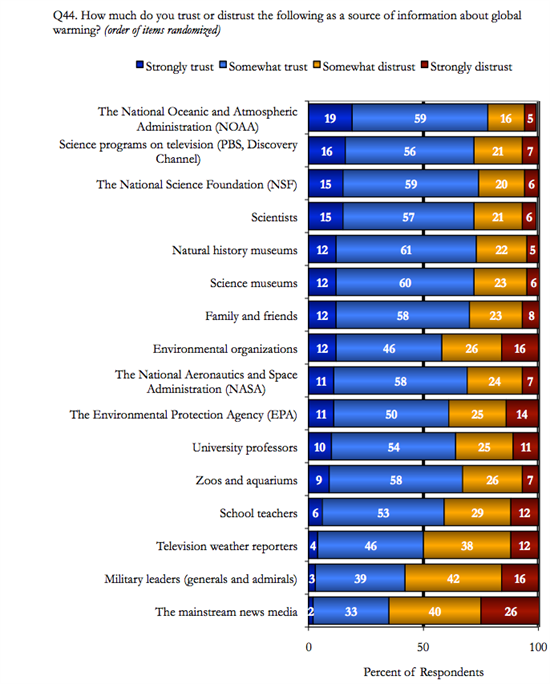 4. Mental models
4. Mental models
The survey also wanted to see how Americans picture the climate system - do they think that it's vulnerable to human activities, or do they believe it'll stay stable regardless of what humans do?
It offered five different descriptions of climate models and asked respondents which most closely corresponds with their own perception of the climate system:
Fragile: Earth's climate is delicately balanced. Small amounts of global warming will have abrupt and catastrophic effects.
Threshold: Earth's climate is stable within certain limits. If global warming is small, climate will return to a stable balance; if it is large, there will be dangerous effects.
Gradual: Earth's climate is gradual to change. Global warming will gradually lead to dangerous effects.
Random: Earth's climate is random and unpredictable. We do not know what will happen.
Stable: Earth's climate system is very stable. Global warming will have little or no effects.
As the graph below shows, most people chose 'threshold', indicating that they think the more the climate warms, the worse the effects will be.
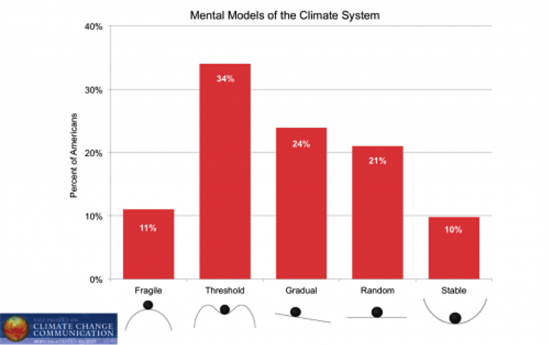
Americans' mental models of the climate system (Data Source: Leiserowitz et al., 2010).
5. Cross-referencing mental models with 'belief' in climate change
The researchers also asked: Do you think global warming is happening? Overall, 63 per cent said they think it is, 19 per cent said no, and 18 per cent said they didn't know.
Cross-referencing these answers with the previous question provides some interesting insights into people's 'mental models' of climate change.
The majority of Americans who chose the Fragile, Threshold or Gradual models said they think climate change is happening. Meanwhile, most of those who chose the Random model either said they didn't know whether climate change is happening or do not accept that it is. Respondents who chose the Stable model tend not to agree climate change is happening.
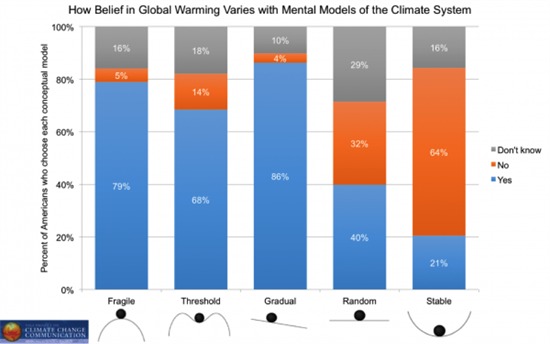































 Arguments
Arguments






























2. "The sun" should have been asked as "Changes in the sun". Otherwise it looks interesting about what Americans think about this science topic, especially surprising that American-type humans think anything about petrol. I'm testing that when I cross the border this summer weekends.
I am one of the 73% of Americans who--incorrectly according to this article--think the ozone hole probably contributes at least a small amount to global warming. Here's my reasoning. Stratospheric ozone absorbs ultraviolet light (UL), preventing it from reaching the surface of the Earth. The ozone hole permits more UL to reach the Earth's surface. To balance that increased incoming solar radiation, the Earth's surface temperature would need to increase. So the ozone hole would be expected to increase global warming. Is my reasoning incorrect?
Joel_Huberman @2, the reduction in stratospheric ozone mostly results in ultraviolet light (shortwave radiation) that would have been absorbed higher in the stratosphere being absorbed lower in the stratosphere, although some does get through to the troposphere. That does indeed have a warming effect. However, it also cools the stratosphere. The stratosphere reradiates the energy absorbed from UV light as IR radiation (longwave radiation). This is mostly reradiated by CO2, H2O and O3 (ozone). Reducing the temperature of the stratosphere by removing O3 also reduces the amount of IR radiation radiated from the stratosphere to the troposphere - a cooling effect. Further, reducing they O3 reduces that radiation directly by reducing the proportion of the atmosophere that can re-radiate the IR radiation downward (also a cooling effect). The question then becomes which of these effects dominates - the warming effect from increased UV, or the cooling effect from reduced IR.
The IPCC AR5 says this:
So by the best judgement of the IPCC, your reasoning is good, but incomplete. The result is that you have probably made a small error. (Probabily because a positive forcing is still within the error bounds.)
Here is the historical forcings for both tropospheric and stratospheric ozones from AR5 (Figure 8.7):
Tom Curtis @ 3: Many thanks for your helpful, interesting explanation. I should have thought of referring to the IPCC AR5 report. But the uncertainty in, and low magnitude of, the IPCC's estimate of the stratospheric ozone RF suggest that the "correct" response to the question in the poll (discussed in the article by Ros Donald above) should have been either "a little", "not at all", or "don't know". It's good to see that 39% of Americans responded correctly (in my view) to this tricky question. In other words, I quibble with Donald's statement that 73% responded incorrectly.
Joel_Huberman @4, if I was being pernickity I would point out that "climate change" and "global warming" are not strict synonyms, and that the ozone hole is having a significant impact increasing wind speed near Antarctica, which is a type of climate change. Such hair-splitting exactness is, however, inappropriate when "criticizing" public communication where the important thing (and the rare thing in most media) is to get the fundamentals right.
In this case the fundamentals are that stratospheric ozone more likely acts against global warming than advances it. Whether it acts against or in favour of it, the total effect is very small relative to the effect of tropospheric ozone, itself a small effect relative to that of CO2, though comparable to that of methane. Given that, I am not going to quibble about Donald's statement. It accurately reflects the best current knowledge.
With regard to your assessment, "I don't know", while probably an accurate assessment is an assessment of the respondents knowledge, not of the impact of stratospheric ozone. It is a non-response rather than a correct response. Further, "possibly a little bit" is accurate, but "a little bit" is inaccurate on current knowledge. On the other hand, "not at all" is not the same as "slightly negatively" so that it could also be considered technically wrong so if you want to count both statements as "correct", fair enough. That leave 77% of Americans who claim knowledge in error, with 19% of all Americans at least knowing enough to know they are completely uninformed on the topic. Not a good performance, though I have no reason to think my fellow Australians would do any better.
[JH] Is "pernickity" Australian for "persnickity"?
[JH] I think you will find that "persnickity" is North American for the English "pernickity". Check your favourite (English for "favorite") dictionary.
[JH] What language is spoken by Aussies?
[PS] Apparently the same language as the English given "pernickity" and "favourite" but with terrible vowels. (and a lot of "colloquialisms").
[JH & PS],
Tom@5, by using "pernickity" (sic!), he made a typo, adopted by urban slang. Unless he meant to use urban slang here, which is unlikely.
The correct spelling of the term is "pernickety" (brit.) or "persnickety" (amer.)
Australian written language (excluding local slang terms) is very close to British English, always distinct from American.
Joel
The reality is a bit more complex. Yes the ozone hole allows energy to reach the surface rather than be absorbed in the stratosphere. However, because this is happening in just the Antarctic its effect is only modest compared to if the effect were global. Still the same amount of energy absorbed is unchanged, just variations in its location and altitude of absorption.
The ozone hole is having another effect which is counter-intuitive - it is cooling Antarctica.
Antarctica is surrounded by powerful air currents that tend to isolate it from weather systems further north which otherwise can transport heat southwards. This goes under the unfriendly name of the Southern Annular Mode (SAM). One effect of the ozone hole allowing more energy through to low altitude is that it appears to be increasing the speed of the SAM, reinforcing Antarctica's isolation and exerting a cooling effect on the continent. So the increased energy reaching the surface in Antarctica due to the hole is probably outweighed by the reduction in energy reaching Antarctica from lower latitudes due to the increased blockage caused by the SAM.
So, counter-intuitively, the rest of the planet may be warming a fraction faster because Antarctica is warming slower because of the Ozone Hole.
There was a discussion of this a few years ago at RealClimate here.
[PS] Interesting as this discussion is, it is also very offtopic. Could I suggest that it be taken to a more appropriate thread please? (Maybe this one)